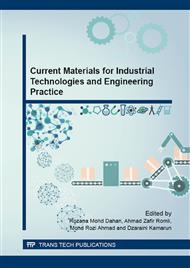p.160
p.165
p.171
p.178
p.185
p.191
p.198
p.203
p.209
Effect of Processing Method on Thermal Behavior in PLA/PEG Melt Blending
Abstract:
The dispersion of PEG acts as plasticizer in PLA blends were investigated using thermal analysis. The comparisons were made between two melt processing method, twin screw extruder and two-roll mills to study how it will affect the Tg, Tc and Tm of blends in DSC analysis. The TGA behavior was also studied for two-roll mills processing method to confirm the effect of PEG loading in PLA on degradation and amount of residue left after analysis. In DSC analysis, it can be seen clearly, the PEG loading decreased the glass transition temperature in all blends compares to neat PLA. For twin screw extruder blending, the crystallization peak existed for some blend. It was difference for two-roll mills blends where the crystallization peak absent in all blends with PEG loading. The presence of PEG gave no significant variation on melting temperature peak for both processing method.
Info:
Periodical:
Pages:
185-190
Citation:
Online since:
December 2015
Keywords:
Price:
Сopyright:
© 2016 Trans Tech Publications Ltd. All Rights Reserved
Share:
Citation:


